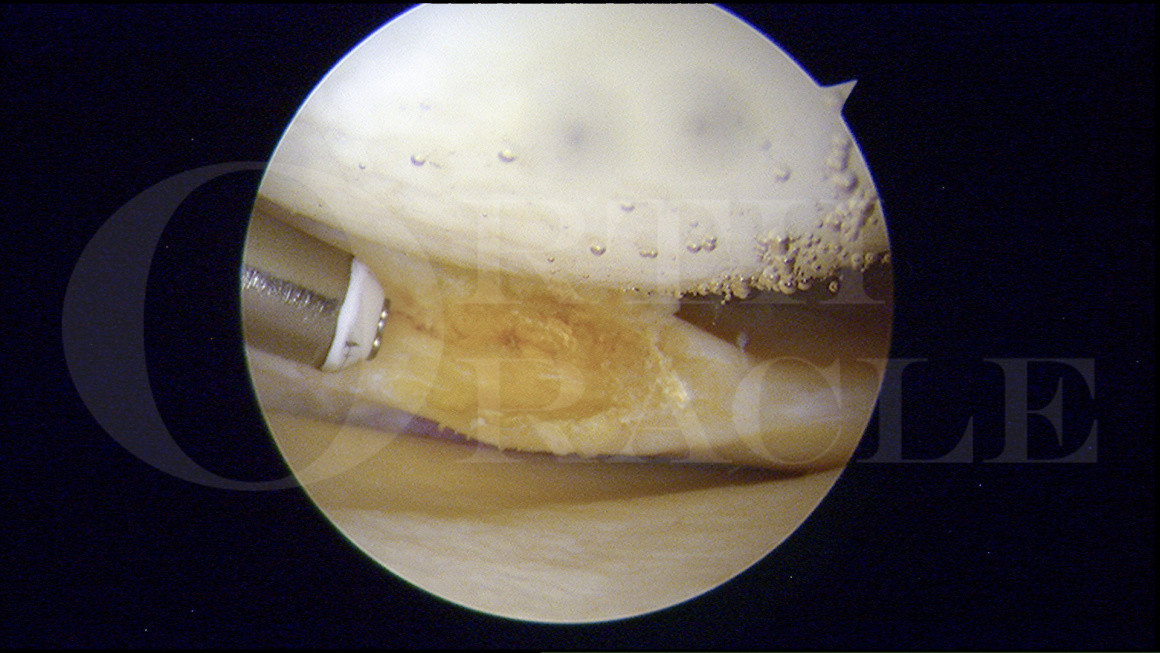Arthroscopic medial menisectomy and chondroplasy of knee
Overview

Subscribe to get full access to this operation and the extensive Knee Surgery Atlas.
Professional Guidelines Included
Learn the Arthroscopic medial menisectomy and chondroplasy of knee surgical technique with step by step instructions on OrthOracle. Our e-learning platform contains high resolution images and a certified CME of the Arthroscopic medial menisectomy and chondroplasy of knee surgical procedure.
The meniscus is a vital component of the knee. Its function is to transmit load over as wide an area as possible between the femur and tibia. From the advent of arthroscopic techniques, the meniscus has often been the site of surgical intervention. Unfortunately most of this historic effort has been in performing meniscectomy or partial meniscectomy.
As arthroscopic ability improved and the industry developed devices to help surgeons, then preservation surgery became more prevalent, although meniscal repair unfortunately is still less common than partial meniscectomy.
However when the meniscus is sufficiently degenerate to the extent that a repair will not hold, then there is still a role for partial and even sub-total meniscectomy to remove unstable meniscal tissue. It must be stressed though, that the vast majority of degenerative meniscal tears can safely be managed non-operatively.
The meniscus degenerates as part of the degenerative process in arthritis. Consequently there are often incidental diagnoses made of meniscal ‘tears’ on MRI which really represent the start of arthritis.
There has been much controversy about the role of arthroscopic meniscectomy. On one side the proponents of non-operative management saying there is no role for arthroscopic meniscectomy for the degenerate meniscus, whereas there have been two sets of guidelines (ESSKA and BASK) developed from experienced user groups, with Delphi Consensus principles, to target the appropriate use of arthroscopic techniques in selected cases.
The BASK guidelines dissuade surgeons from performing arthroscopic surgery on degenerative menisci in ‘arthritic knees’, but promote urgent arthroscopic assessment for locked knees ideally repairing the meniscus. The BASK guidelines also describe the concept of the ‘target lesion’ which represents a specific flap of meniscal tear which is perceived to be the site of mechanical symptoms and pain. This is particularly relevant for tears extruded into the medial gutter lying underneath the meniscus.
On the opposite side of the fence where Physiotherapy or off-loader bracing should be the main weapon is the degenerate complex tear with maceration of the meniscal tissue and no discrete flap tear.
This technique describes my technique for partial meniscectomy; this represents less than half of the arthroscopic meniscal procedures I perform.
It is also vital to remember that in a degenerative meniscal lesion, appropriate non-operative management should be attempted prior to surgical intervention, once the decision has been made that this is not a repairable tear. Sometimes there is a role for steroid injection, be that ultrasound-guided, direct intra-articular or palpation-directed peri-articular at the site of maximal tenderness.
The two key papers related to this giving practical guidelines are listed below, but please also look at the Results section for more key papers on Meniscectomy:
Arthroscopic meniscal surgery: a national society treatment guideline and consensus statement.
Abram SGF, Beard DJ, Price AJ; BASK Meniscal Working Group.
Bone Joint J. 2019 Jun;101-B(6):652-659. doi: 10.1302/0301-620X.101B6.BJJ-2019-0126.R1.
PMID: 31154847
The Knee Meniscus: Management of Traumatic Tears and Degenerative Lesions
Philippe Beaufils, Roland Becker, Sebastian Kopf, Ollivier Matthieu, Nicolas Pujol
EFORT Open Reviews
2017 May 11;2(5):195-203. doi: 10.1302/2058-5241.2.160056. eCollection 2017 May.
PMID: 28698804 PMCID: PMC5489759 DOI: 10.1302/2058-5241.2.160056
Readers will find the following OrthOracle techniques also of interest:
Meniscal repair using Smith and Nephew fast-fix 360 system and knee arthroscopy
Trans-tibial meniscal root repair using Smith and Nephew Firstpass mini
Knee arthroscopy and microfracture of osteochondral defect
Author: James Murray
Institution: The Avon Orthopaedic Centre, Southmead Hospital, Bristol.
Clinicians should seek clarification on whether any implant demonstrated is licensed for use in their own country.
In the USA contact: fda.gov
In the UK contact: gov.uk
In the EU contact: ema.europa.eu



















